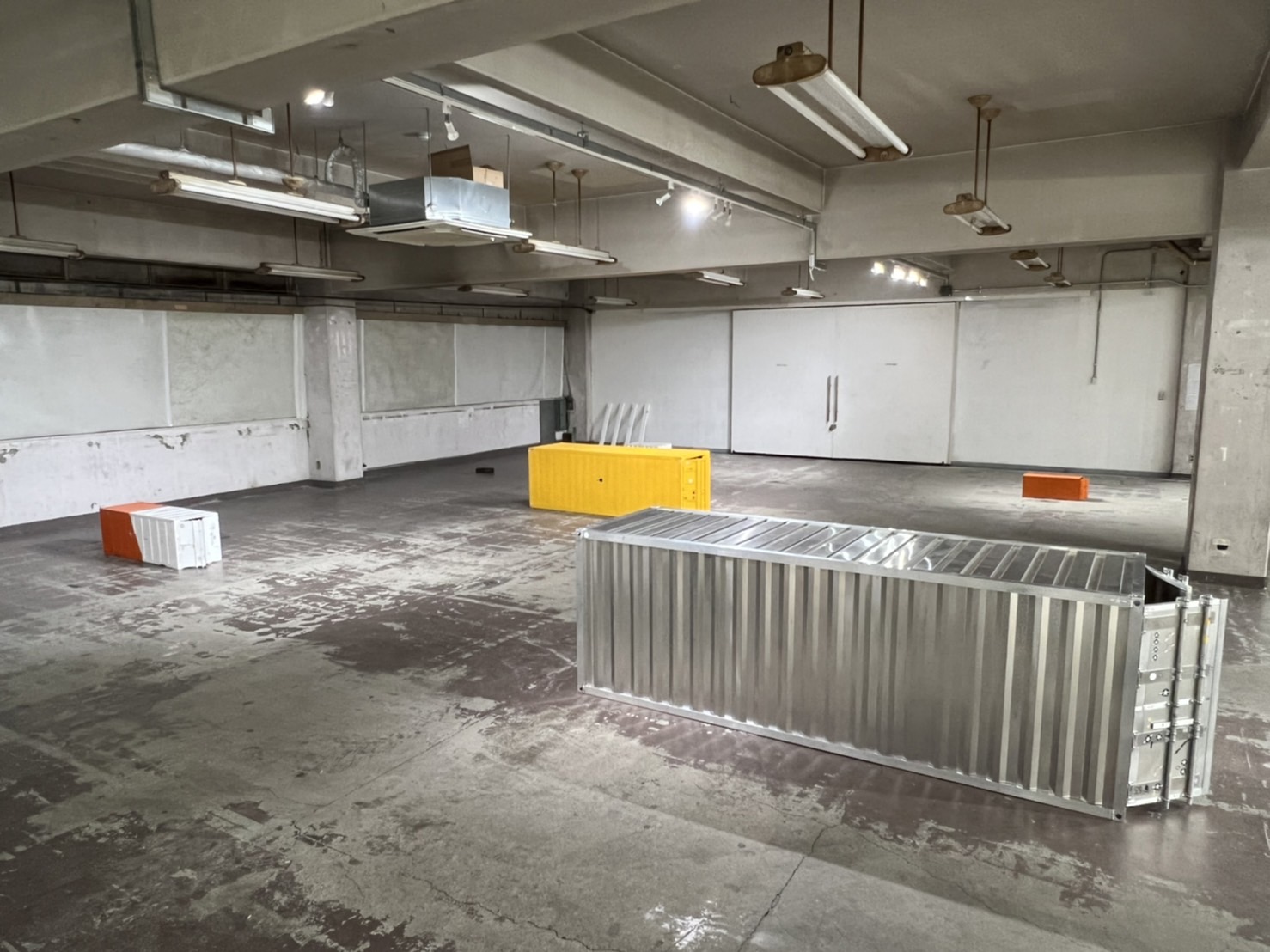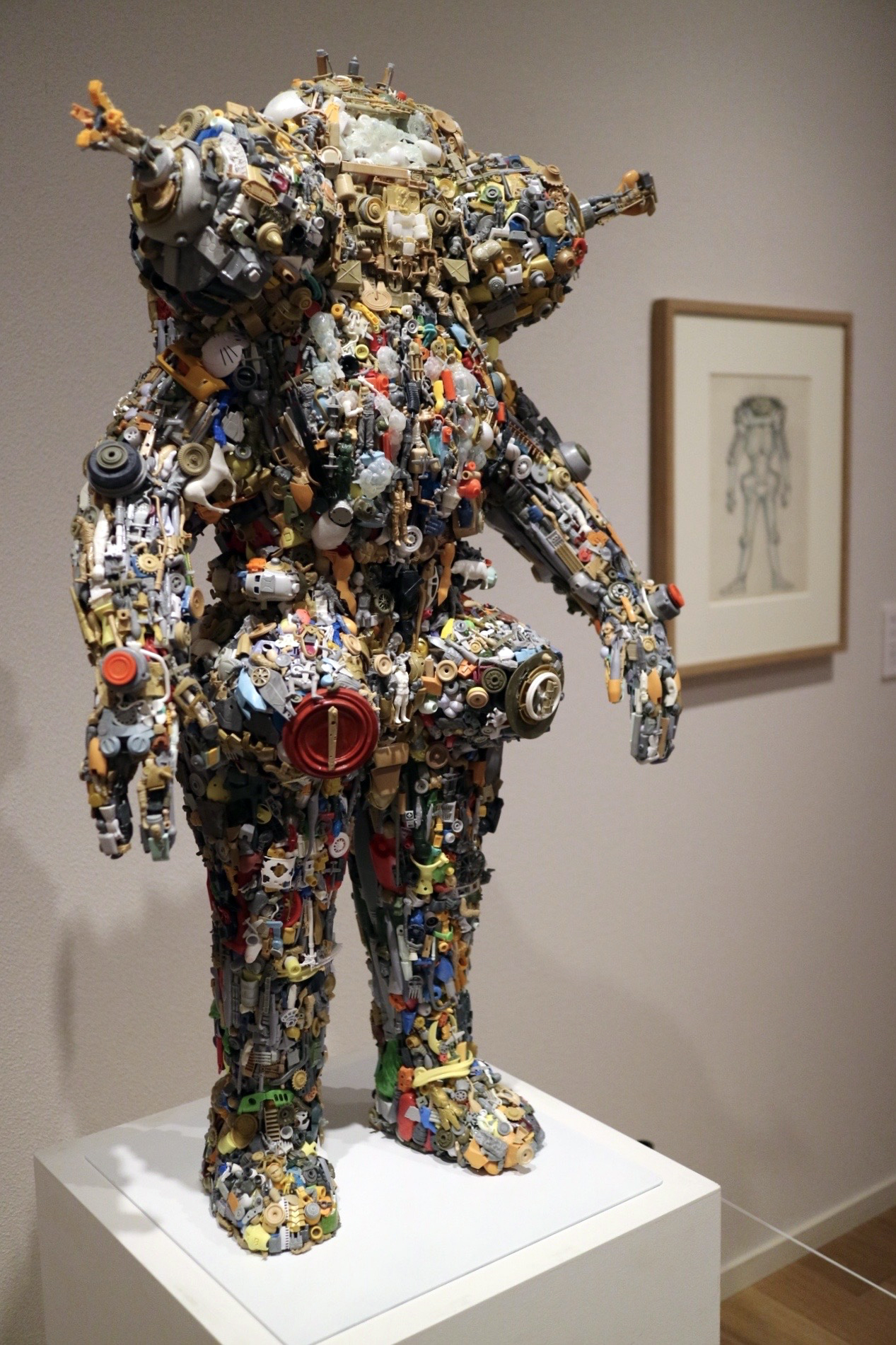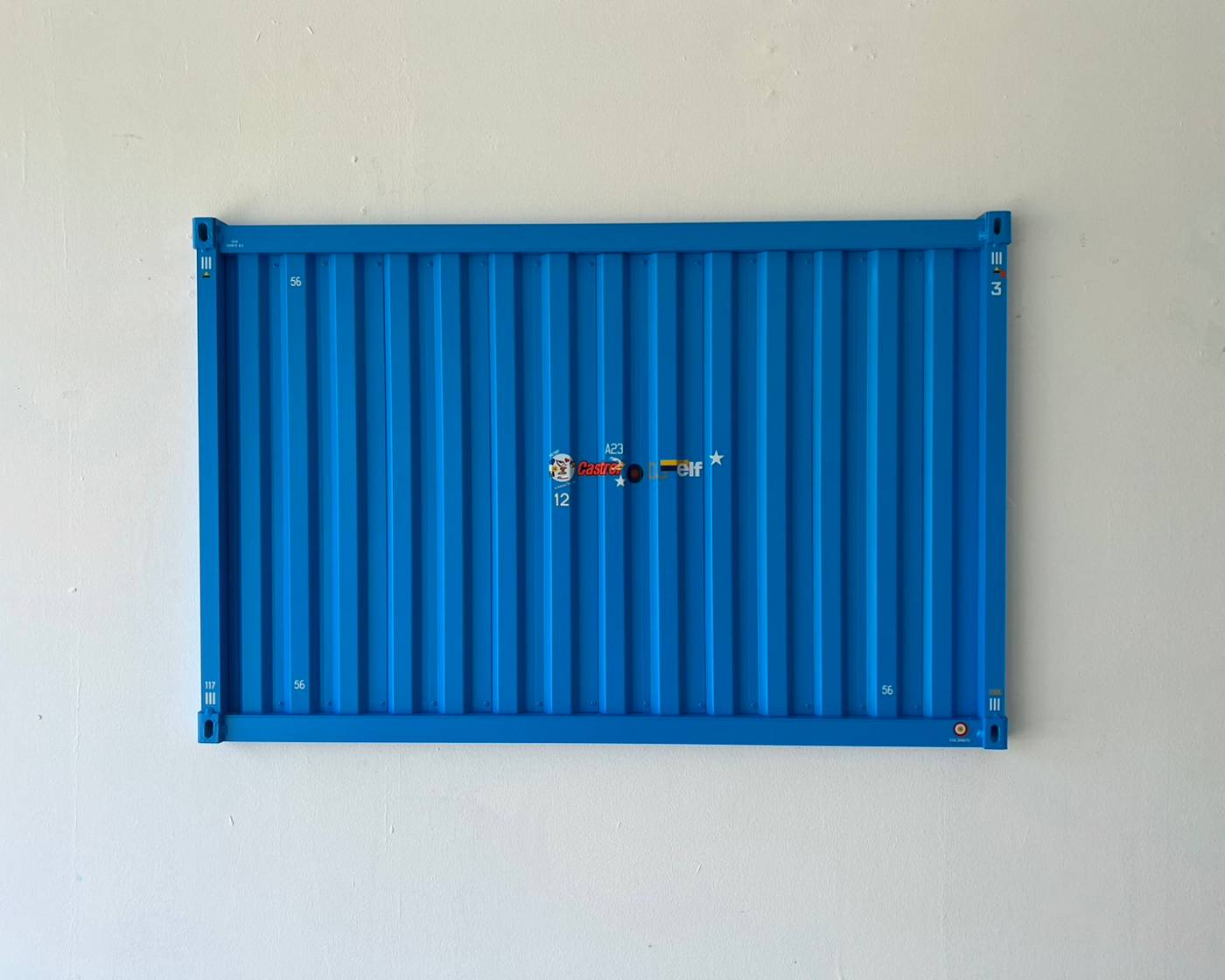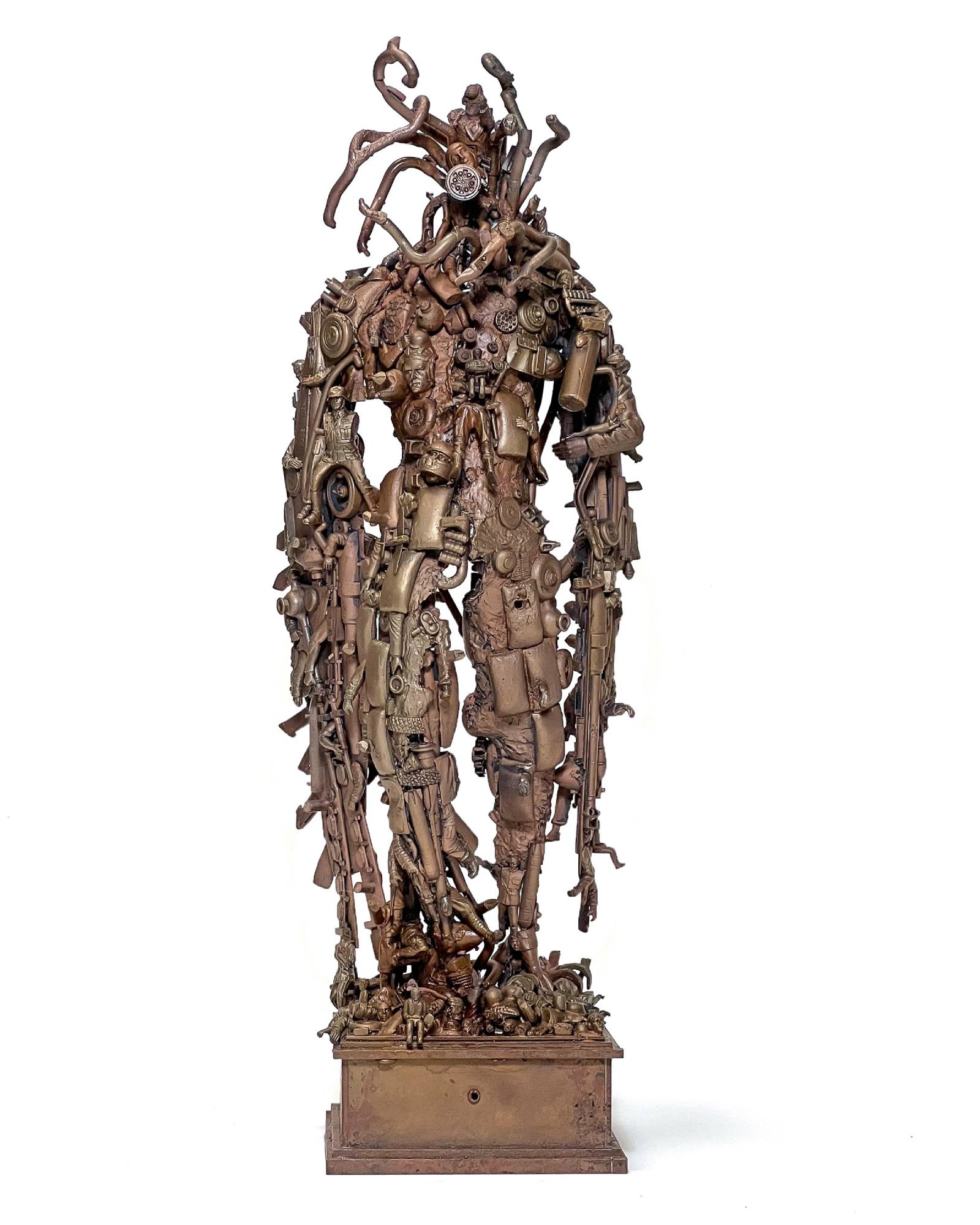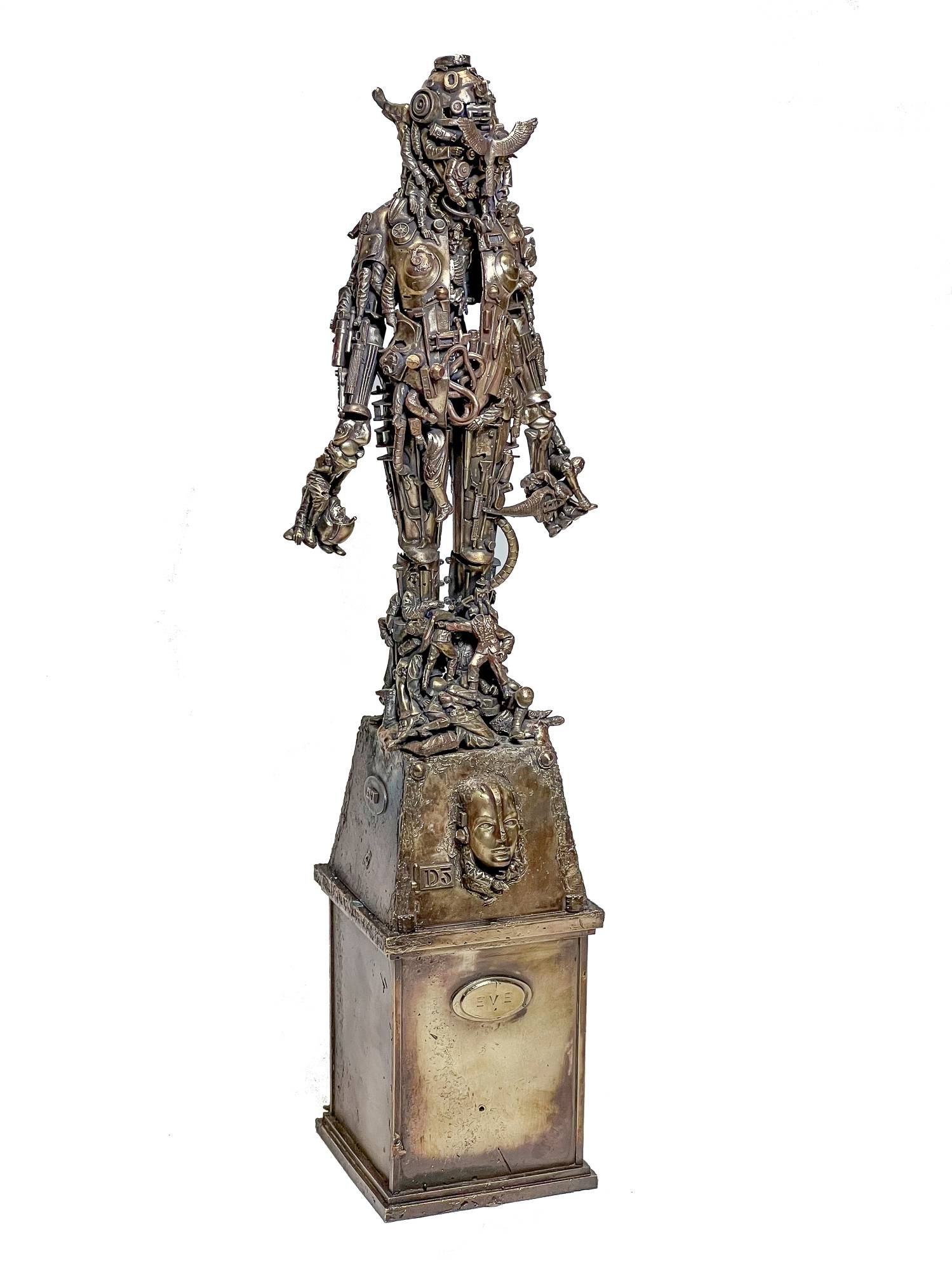大森記詩
Kishi OMORI
Unscaled installation work 2022
KISHI OMORI ARTIST PROFILE
Each of Omori’s sculptures capture the essence of the scale surrounding himself and the world. Using collected industrial materials and orphaned pieces from plastic models, he creates casts that destroy the original form of these disused products and give them new life. Guided by a strong concept, Omori’s style is characterized by meticulous attention to detail, delivering an energetic and striking take on the relationship between art, artist, and the world. The “sense of scale” we unconsciously perceive is constantly evolving, and is affected by an ever-changing world along with one’s ever-changing place in it. By exploring the origins and history of his own sense of scale, Omori creates bronze sculptures that function as a representation and extension of the present, making us aware of this evolution through his artwork. He stands as an unparalleled and extraordinary sculptor.
Since his days as a student, Omori has continuously pondered his own “sense of scale”. Where does one’s sense of size come from when creating artwork? It’s not something innate; external influences play a significant role. It impossible for one to objectively view their own scale without understanding the size of the world around them, but what could we use to base that comparison on? In Omori’s case, the plastic models he was passionate about from a young age formed the foundation of that sense.
Omori’s bronze sculptures can be considered the third chapter of his artistic journey. The first chapter involved assembling plastic models. The second chapter involved removing parts of these plastic models from their intended environment, combining different motifs, colors, and scales to create a single sculpture from a patchwork of components. Finally, the transition occurred. Assembled pieces were destroyed, replaced entirely by bronze, giving birth to a new form of artwork. The fragments of motifs, now all of one color and material, are merged completely into one entity. They are no longer a collection of numerous small components that offer little artistic value individually, instead they have become a single indivisible artwork. People often gauge the scale of the world they inhabit with the things in front of them (like pens or skyscrapers). However, when confronted with Omori’s artworks, the perceived size one had about the pieces gets overturned. His works contain a multitude of scales, challenging our senses and raising questions about how we even perceive size to begin with. How can we even begin to estimate the scale of events happening beyond the screens we hold? We might not even have a basis for estimation.
In this third phase of Omori’s career, there has been a noticeable challenge towards bronze, along with a reflection on his own position in the history of sculpture. The prototypes for his bronze sculptures are derived from the assembly works of plastic models he tackled earlier in his career. Owing to the fact that the shapes in these works were too intricate to be replicated with wax, a unique casting method called “lost plastic model precision casting” was employed. Going forward, the artist’s sculptures would be cast by pouring bronze into the space vacated by the destruction of the original model. This was made possible through collaboration with the leading figure in precision casting in Japan, Sakuraibijutsuichuzo.
It is crucial to note that even the pedestal is cast, and emerges as an integral piece of the sculpture itself. In modern bronze sculptures, if the pedestal is made of a different material, it might not be recognized as part of the sculpture and could become unseen. Because Omori’s sculptures are meant to challenge one’s sense of scale, it is necessary to unify everything into one material to prevent compromising his vision.
In this series, Omori has included figures of soldiers and other human bodies from military model sets as a common motif. Serving as a definitive point of recognition and size reference, human body parts are easily recognizable, and provide a striking reminder to the audience of the scale of the concepts the artist is addressing. This is also the reason human figures were included in plastic modeling kits at all.
At first glance, Omori’s bronze artworks appear to be beautifully crafted sculptures with perfect forms. However, one notices upon closer inspection that the scale of component parts, juxtaposed next to each other, varies significantly. Furthermore, the artist refrains from treating the pedestals as conventional bases, instead using them as an uncommon medium to elaborate on the theme of his work. For instance, small statues are cast into the back of the pedestals of the artworks “ADAM” and “EVE”, engendering these pieces with a certain monumentality that results in the impression that they are just small scale replicas of statues many times their size. To achieve this effect, he refrains from treating the pedestals as conventional bases. Whether viewed from a distance or up close, his bronze artworks challenge our sense of scale.
While the lost plastic model precision casting technique enables a sculpture to be cast in the exact form of its prototype, it makes replication or mass-production of a piece impossible due to the destructive nature of the process. While the bronze sculptures might appear like identical replicas of their prototypes at first glance, the truth is that the prototype has been utterly consumed, supplanted by a new material: bronze. Consequently, the reconstructive aspect of mass-produced items that the artwork initially possessed transitions to a different dimension, turning into a unique sculpture. However, this seemingly irreplicable image exists concurrently with the mass-produced items that it was once composed of. The materials the artist uses are commonly available plastic model kits, with many people assembling the exact same product in the exact same way as per the instruction manual. Despite the disappearance of the works created in the second phase, there exist countless identical components worldwide.
Much like how we ponder the recently uncovered statues excavated from Roman baths or ritual sites, Omori fantasizes about his bronze sculptures altering how our era will be perceived by future generations. Even if someone recognizes a singular bronze sculpture or notices its unusual design, the prototype that could answer any questions no longer exists, and any hope to replicate it is practically unattainable. On the other hand, the actual parts or kits used to build plastic models are ubiquitous. There are enough exact copies of each part that constituted the original prototype to produce hundreds of exact copies; they exist but don’t exist, or perhaps they don’t exist but could.
Today, plastic models serve as a symbol of Japanese culture despite their foreign roots. These intriguing toys, designed to resemble disassembled finished products and then reconstructed into their intended form, arrived on the island nation of Japan in the post-war era. This toy that builds the whole from its parts evokes an image of Japan itself. In recent times, there’s been a phenomenon in Japan where anything and everything, ranging from food to anime, is transformed into a plastic figurine. The fact that Omori’s particular style of creation was birthed and cultivated in this environment is intriguing, and it’s likely that he will further delve into his own relationship with this plastic figure culture while expanding research, contemplating the state of the world, and exploring his sense of scale in a global context.
“HARPY”
The title of this artwork is derived from the famed creatures of Greek mythology. Omori’s titles for pieces using steel materials have a simplicity to them, but places his bronze sculptures in contrast by alluding to mythology. The various motifs provided by the plastic models serving as the prototype for this artwork range from real-life objects to more fantastical elements, creating a diverse and leviathanic array. Omori perceives this sculpture’s lack of boundaries as akin to mythology itself. Just as described in the legends of the harpy, the figure adorned with various plastic model parts epitomizes voracity itself, evoking the insatiability of human desires and actions. The towering stance exudes an ominous and divine presence, staring deep into the viewer and drawing them closer to its eldritch form. The matte finish on the surface results from the searing of oil, and we also observe the amalgamation of plastic model parts that were originally separate and complete in themselves—like military motifs or bikes—now combined to create an organic form reminiscent of a living being.
“ADAM” AND “EVE”
These twinned artworks typify the movement Omori’s third phase represents. Symbolizing the genesis of the hobby of plastic modeling, a male and female figure are paired together as harbingers of the art form. ADAM features the Cyclops from Ray Harryhausen’s “The 7th Voyage of Sinbad” (at a 1/35 scale), while EVE portrays Fritz Lang’s “Metropolis” character Maria (at a 1/8 scale). Various parts of plastic model kits of diverse scales and types were assembled to create the prototypes, which were then cast in bronze. The casting process brings together these disparate and otherwise incompatible design motifs, and integrates them all into monochromatic tones. The choice to limit the statues to monochrome was made as a direct homage to the films that inspired the works. This pursuit of a unified aesthetic also prompted the selection of these two different plastic model kits released by the same manufacturer during the same period. Both the Cyclops and Maria are motifs that constitute the origin of modern cinematic language in regard to monsters, robots, and the sci-fi genre. Despite their patchwork construction, ADAM and EVE exhibit excellent shapes, revealing the artist’s remarkable sculpting skills and meticulous craftsmanship. The tones that might appear different from the bronze’s copper color are due to the use of a brass brush in the finishing touches. Particularly, EVE evokes the image of Maria and pays homage to another iconic sci-fi design: C-3PO, from George Lucas’s “Star Wars.” The models used for special effects in Star Wars were also crafted by combining parts of plastic models to create intricate details. Throughout the forms, one can see various parts of the human body embedded everywhere from the statues to the pedestals. On the side of the pedestal, small soldier figures can be seen, creating a sense of looking up at a colossal monument while feeling small oneself. Conversely, upon closer inspection, one might feel like they’ve become a giant. This peculiar sense of scale and a certain poignant quality are characteristic of Omori’s artworks, and no matter how much one observes, they are continually drawn into this exquisite sensation, never tiring of it.
1990 東京生まれ
2013 東京藝術大学美術学部 彫刻専攻 卒業
2015 東京藝術大学大学院美術研究科 修士課程彫刻専攻 修了
2018 東京藝術大学大学院美術研究科 美術専攻 彫刻研究領域 博士後期課程 修了
■個展
2014「CASE RED」ギャラリー現(東京)
2016「CASE YELLOW」ギャラリー現(東京)
2018「Training Day」苫小牧市美術博物館(苫小牧)
2019「EMPIRE OF THE PATCHWORKS」ギャラリーHIROUMI(東京)
■グループ展
2013「藝大アーツイン東京丸の内2013」丸ビル(東京)
2015「STEELERS」天王洲セントラルタワー(東京)
2016「Art and Air」苫小牧市美術博物館(苫小牧)
2017「ラブラブショー2」青森県立美術館(青森)
2018「ポート・コレクティブ」Hue Universal Gallery [HUG](札幌)
2018「GRAVITY」天王洲セントラルタワー(東京)
2019「TOKUNSTERLEM」クンストアカデミーミュンスター(ドイツ/ミュンスター )
2019「時間/彫刻 -時をかけるかたち-」東京藝術大学美術館 陳列館(東京)
2020「生誕100年 | ロボットと芸術 ~越境するヒューマノイド~」苫小牧市美術博物館(苫小牧)
2020 「Public Device – 彫刻の象徴性と恒久性」東京藝術大学美術館 陳列館(東京)
2021 「コレクション展 2021-1:鬼が来た_成田亨:怪獣デザインの美学」青森県立美術館(青森)
2021「コレクション展 2021-2:ユーモアと祝祭」青森県立美術館(青森)
■アートフェア
2020 ART OSAKA WALL(大阪)
2022 Art Stage Osaka(大阪)
2022 ART OSAKA Expanded Section(大阪)
【受賞】
2013 三菱地所賞
1990 Born in Tokyo
2013 BFA on Sculpture, Tokyo University of The Arts, Tokyo, Japan
2015 MFA on Sculpture, Tokyo University of The Arts, Tokyo, Japan
2018 PhD on Sculpture, Tokyo University of The Arts, Tokyo, Japan
■Solo Exhibitions
2014 CASE RED (gallery Gen, Tokyo)
2016 CASE YELLOW (gallery Gen, Tokyo)
2018 Training Day (Tomakomai City Museum of Art, Hokkaido)
2019 EMPIRE OF THE PATCHWORKS (Gallery HIROUMI, Tokyo)
■Group Exhibitions
2013 GEIDAI ARTS IN TOKYO MARUNOUCHI 2013 (Marunouchi building, Tokyo)
2015 STEELERS (Tennoz central tower, Tokyo)
2016 Art and Air (Tomakomai Museum of Art, Hokkaido)
2017 LOVE LOVE SHOW2 (Aomori Museum of Art, Aomori)
2018 GRAVITY (Tennoz central tower, Tokyo)
2018 Port Collective (Hue Universal Gallery [HUG] Hokkaido)
2019 BODY SCALE case01 Tracer (Turner Gallery, Tokyo)
2019 TOKUNSTERLEM (Kunst Academy Munster, Munster, Germany)
2019 Time in contemporary sculpture (The University Art Museum Chinretsukan Gallery, Tokyo)
2020 Public Device – Symbolism and Permanence of Sculpture (The University Art Museum Chinretsukan Gallery, Tokyo)
2020 The 100th Anniversary | Robot and the Arts – Humanoid Crossing boundaries (Tomakomai Museum of Art, Hokkaido)
2021 AOMORI MUSEUM OF ART《Training Day – Patchwork Super Robot》(Aomori Museum of Art/ Aomori)
■Art Fairs
2020 ART OSAKA WALL (Osaka)
2022 Art Stage Osaka (Osaka)
2022 ART OSAKA Expanded Section (Osaka)
■Awards
2013 Mitsubishi Estate Award
